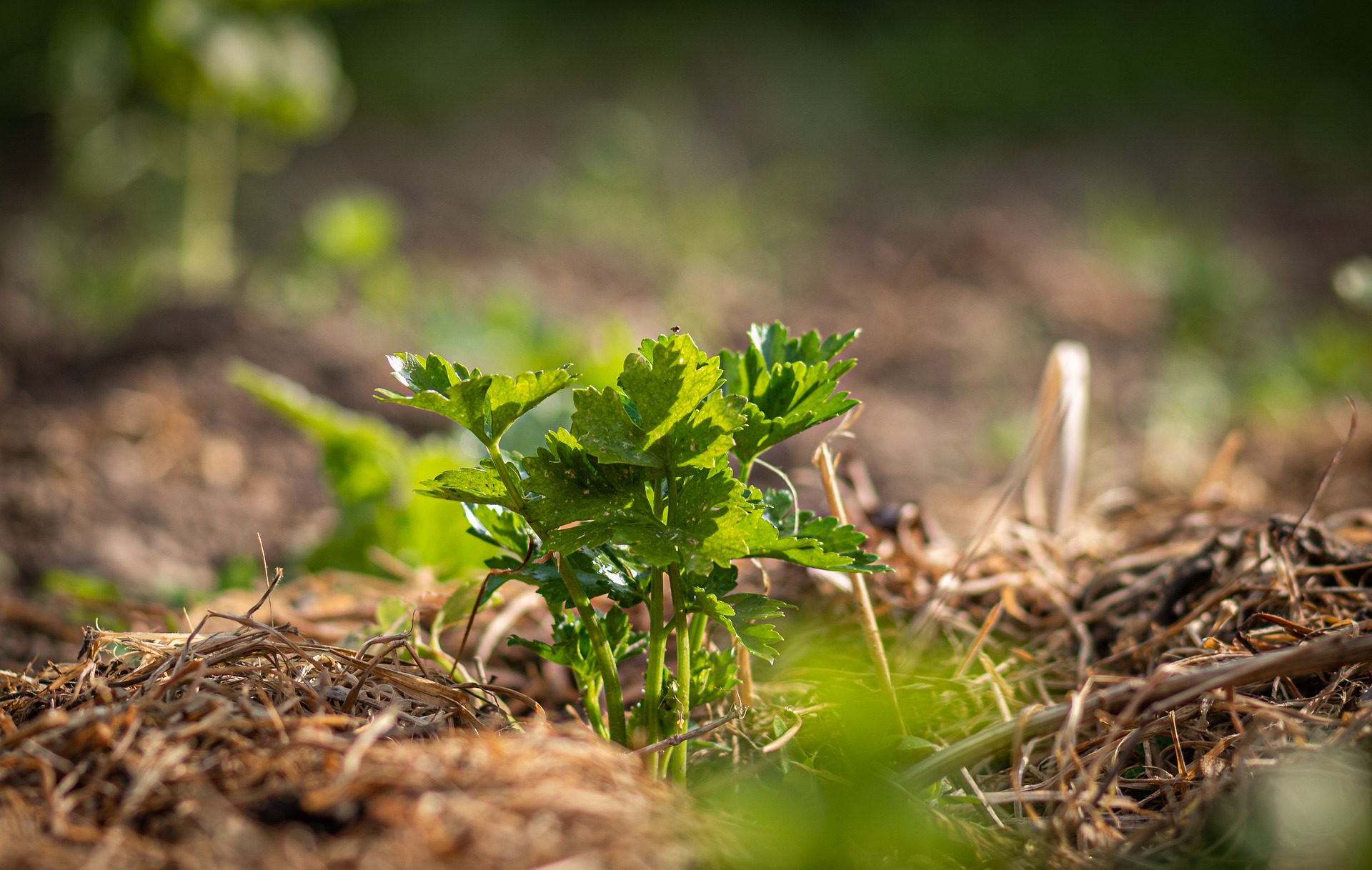Better results can be expected if plants are well fed, and protected from extreme temperatures. One of the ways to achieve this is through mulching. Mulching means placing the organic or inorganic matter on the surface of vegetable beds and around fruit trees to maintain moisture in the soil.
Using mulch is the best way to conserve water in areas that do not receive an abundance of rain, as it reduces water loss through evaporation from the surface of
the soil.
Mulching can also be used to regulate the soil temperature by keeping it warmer in colder climates and cooler when it is hot, thereby creating a comfortable environment
conducive to growth.
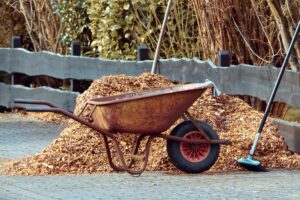
Nature is generous with organic materials suitable for mulch. (Source: Pixabay)
A layer of at least 5 cm of mulch should be spread on top of the vegetable or flower bed, or around fruit trees, but should not be mixed with the soil. Add more mulch throughout the growing season if the beds must remain covered to regulate temperature and water loss.
Water evaporates from the soil, while transpiration refers to moisture released by the leaves of plants into the atmosphere. Evapotranspiration refers to both these processes and should be considered when determining the quantity of water your garden or orchard needs.
Added bonuses of mulching are that it keeps insects at bay unless they hide in chunky mulch, and weeds are less likely to proliferate under a layer of mulch.
Organic material suitable for mulching
Wood chips and bark
Wood chips and bark are most often used to keep the soil moist. It also keeps weeds at bay, as it prevents them from getting enough sunlight to grow.
Move the wood chips aside before planting seedlings in a vegetable bed.
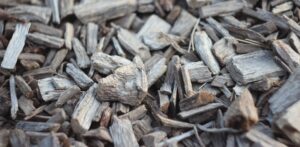
Wood chips are suitable for mulch. (Source: Pixabay)
Be aware that mulch consisting of woodchips, bark or leaves can create hideouts for unwanted insects and other critters, like some bugs, snails, and slugs. One way to remove snails and slugs is to set a beer trap for them. A plastic container with beer in it in a vegetable bed will invite them to help themselves and they will not survive the hangover. Another way to get rid of the slimy critters is to keep free-roaming chickens that will enjoy the tasty snack.
Fears that wood chips can introduce fungal diseases to your vegetables have not been proven. Fungi in wood chips are mostly decomposers, which helps the wood break down. Under healthy soil conditions, harmless, beneficial fungi may outcompete disease fungi, while healthy plants are not susceptible to them.
Another myth is that the wood chips will absorb nutrients from your garden bed, but as the wood chips decompose, they will rather release more nutrients than they will take away. Some farmers believe that mulch can rectify poor soil by breaking down and releasing nutrients into it.
It is advisable not to use wood chips in compost or work them into the soil, but rather just use them as topdressing. Also, keep it away from trunks of trees and shrubs and the stems of your vegetables.
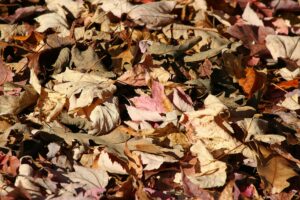
Fallen leaves must be shredded and allowed to rot a bit before using them as mulch. (Source: Pixabay)
Grass clippings
Freshly cut lawn must be allowed to dry out in the sun for at least a day before using it as mulch. Be careful not to use clippings when the lawn had been treated with pesticides.
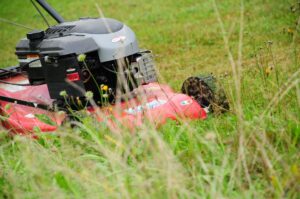
Lawn cuttings must be allowed to dry out in the sun before using it as mulch. (Source: Pixabay)
Shredded leaves
Leaves must be left to mature for a couple of months to neutralise phenols before they are used as mulch. The same applies if you want to use leaves in your compost pile.
Hay and straw
Hay refers to dried material like alfalfa, clover, or grasses that are cut and used as animal feed. Straw refers to the dried stalks of grains like rye, wheat, oats, or barley which have no nutritional value for animals. However, it is useful in a compost heap as brown material, and it is most suitable for mulching.
The disadvantages of hay and straw are that these grains may have been exposed to pesticides, or they may contain weed seeds. This can be solved by leaving the hay or straw outside for a couple of months. This will allow the toxins to be neutralised and the weeds to sprout so you can remove them manually before they go to seed.
Rotting hay or straw may cause fungal infection if they touch the stems or leaves of your vegetables or trees, but this can be overcome by keeping the mulch a few inches away from the stems.
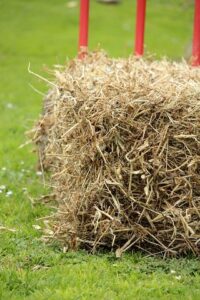
Straw or hay is ideal mulching material if it has not been treated with pesticides. (Source: Pixabay)
Compost
If you make your own compost and have enough spare after working some into your garden, you can also use it as mulch. Put a layer of two to four inches deep on top of the bed, but keep it well away from the stems. Regularly add some more during the growing season.
Cardboard
Cardboard is cheap or even free if you collect it from a store near you. Some stores have recycling bins into which they discard empty boxes which you may take. It works great for suppressing weeds and can be put down on garden paths before adding a layer of wood chips. In fact, a layer of cardboard put on the unwanted lawn or a weedy patch before covering it with a mix of compost and topsoil will make an excellent raised bed without having to remove it first.
Newspapers
Shredded newspapers will work fine, but don’t use glossy paper with coloured ink, like magazines and advertising flyers.
Biodegradable weed mats
These are made of recycled paper and are used as mulch. The advantage is that they let in water, air, and nutrients, which is not the case with plastic sheeting used as mulch. In addition, these mats can be worked into the beds at the end of the season. These can be quite expensive, though. Loosen the soil and install a drip irrigation system before you place the mats on the beds. Install them on a windless day and secure them with earth staples. You can make an opening with a trowel to plant the seed or seedling into the soil underneath. Cover the sheets with mulch before watering.
Other materials
Using pine needles and wood shavings as mulch will raise acidity levels in your soil. Kelp or seaweed, if you can obtain some, can also be used as mulch.
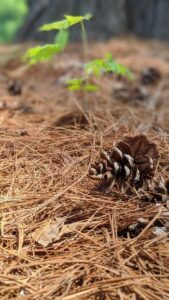
Pine needles used as mulch can change the pH level of the soil. (Source: Pixabay)
Inorganic material
Black, clear, or coloured plastic
Thick polyurethane that is safe for use with food, is preferable. The plastic sheets can be secure with earth staples, which are available at hardware stores, as well as bricks, stones or lengths of wood. Cover the whole bed and cut holes into the sheet for planting your seedlings.
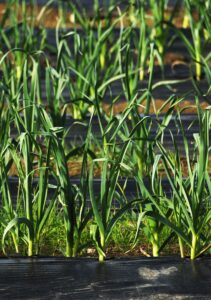
Plastic sheeting is used as inorganic mulch. (Source: Pixabay)
Fibre
Other inorganic materials suitable for mulching include perforated polyester garden fabric or permeable cloth covers. These allow water and a limited amount of heat from the sun through, but can help to keep out cold, heat and insects. It also protects young plants from strong winds that may snap the stems, or against a hot wind that may dry out or scorch the plants. In some areas, it is used to keep windblown sand from covering your seedlings.
Once the material starts to interfere with the plants’ growth, it is time to remove it. Most covers may be strong enough to use again.
References
Different types of mulch to use in your garden. (2016, February 18). Caxton Magazines https://www.gardenandhome.co.za/gardening/how-tos/different-types-of-mulch/
5 good reasons to mulch your garden. (2016, February 18). Caxton Magazines https://www.gardenandhome.co.za/gardening/how-tos/5-good-reasons-to-mulch-your-garden-2/
Iannotti, M. (2021, March 7). What Is Mulch? The Spruce https://www.thespruce.com/what-is-mulch-1402413
The Ultimate Mulch Guide: How to Find the Best Type for Your Garden. (2020, May 26) Good Housekeeping https://www.goodhousekeeping.com/home/gardening/a20706549/how-to-mulch-your-garden/

